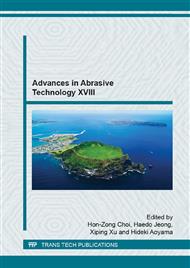[1]
R. K. Pandey, S. S. Panda. Drilling of bone: A comprehensive review [J]. Journal of clinical Orthopaedics and Trauma, 2013, 4 (1): 15-30.
Google Scholar
[2]
A. R. Moritz, F. C. Henriques Jr. Studies of Thermal Injury: II. The Relative Importance of Time and Surface Temperature in the Causation of Cutaneous Burns* [J]. The American journal of pathology, 1947, 23 (5): 695.
Google Scholar
[3]
A. R. Eriksson, T. Albrektsson. Temperature threshold levels for heat-induced bone tissue injury: a vital-microscopic study in the rabbit [J]. The Journal of prosthetic dentistry, 1983, 50 (1): 101-107.
DOI: 10.1016/0022-3913(83)90174-9
Google Scholar
[4]
R. A. Eriksson, T. Albrektsson, B. Magnusson. Assessment of bone viability after heat trauma: a histological, histochemical and vital microscopic study in the rabbit [J]. Scandinavian Journal of Plastic and Reconstructive Surgery and Hand Surgery, 1984, 18 (3): 261-268.
DOI: 10.3109/02844318409052849
Google Scholar
[5]
B. Noble. Bone microdamage and cell apoptosis [J]. Eur Cell Mater, 2003, 6 46-55.
Google Scholar
[6]
G. Augustin, S. Davila, K. Mihoci, et al. Thermal osteonecrosis and bone drilling parameters revisited [J]. Archives of Orthopaedic and Trauma Surgery, 2008, 128 (1): 71-77.
DOI: 10.1007/s00402-007-0427-3
Google Scholar
[7]
K. N. Bachus, M. T. Rondina, D. T. Hutchinson. The effects of drilling force on cortical temperatures and their duration: an in vitro study [J]. Medical engineering & physics, 2000, 22 (10): 685-691.
DOI: 10.1016/s1350-4533(01)00016-9
Google Scholar
[8]
D. L. Brisman. The effect of speed, pressure, and time on bone temperature during the drilling of implant sites [J]. The International journal of oral & maxillofacial implants, 1995, 11 (1): 35-37.
Google Scholar
[9]
S. Iyer, C. Weiss, A. Mehta. Effects of drill speed on heat production and the rate and quality of bone formation in dental implant osteotomies. Part II: Relationship between drill speed and healing [J]. The International journal of prosthodontics, 1996, 10 (6): 536-540.
Google Scholar
[10]
Y. Reingewirtz, S. Szmukler-moncler, B. Senger. Influence of different parameters on bone heating and drilling time in implantology [J]. Clinical Oral Implants Research, 1997, 8 (3): 189-197.
DOI: 10.1034/j.1600-0501.1997.080305.x
Google Scholar
[11]
H. C. Thompson,. Effect of drilling into bone [J]. Journal of oral surgery, 1958, 16 (1): 22.
Google Scholar
[12]
R. C. Vaughn, F. A. Peyton. The influence of rotational speed on temperature rise during cavity preparation [J]. Journal of dental research, 1951, 30 (5): 737-744.
DOI: 10.1177/00220345510300051801
Google Scholar
[13]
P. Bast, M. Engelhardt, W. Lauer, et al. Identification of milling parameters for manual cutting of bicortical bone structures[J]. Computer Aided Surgery, 2003, 8 (5): 257-263.
DOI: 10.3109/10929080309146061
Google Scholar
[14]
K. Denis, G. Van Ham, J. Vander Sloten, et al. Influence of bone milling parameters on the temperature rise, milling forces and surface flatness in view of robot-assisted total knee arthroplasty; proceedings of the International congress series, F, 2001 [C]. Elsevier.
DOI: 10.1016/s0531-5131(01)00067-x
Google Scholar
[15]
J. Chae, S. S. Park, T. Freiheit. Investigation of micro-cutting operations [J]. International Journal of Machine Tools and Manufacture, 2006, 46 (3): 313-332.
DOI: 10.1016/j.ijmachtools.2005.05.015
Google Scholar
[16]
M. Mitsuishi, S. Warisawa, N. Sugita, et al. A study of bone micro-cutting characteristics using a newly developed advanced bone cutting machine tool for total knee arthroplasty [J]. CIRP Annals-Manufacturing Technology, 2005, 54 (1): 41-46.
DOI: 10.1016/s0007-8506(07)60045-6
Google Scholar


